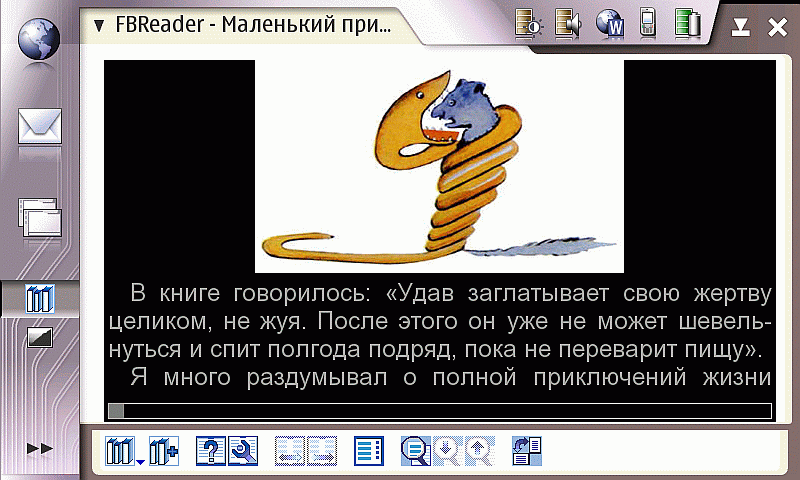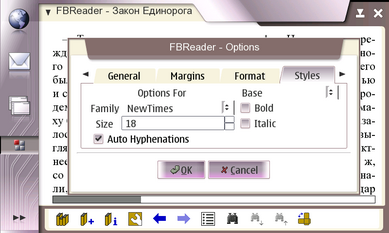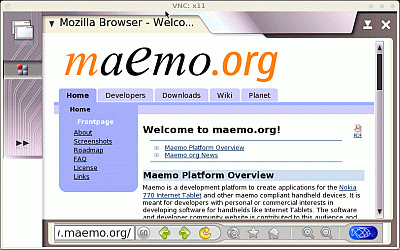The first devices went out, Tommi Komulainen from Nokia writes, but not to the United States yet.
Three companies contracted by Nokia to improve the software base of 770 are joining the GNOME Foundation advisory board, Ziff Davis Media reports.
Last week, three embedded software companies contracted by Nokia to improve Gnome for use in the slightly delayed Nokia 770 Internet Tablet announced that they had joined the Gnome Foundation’s advisory board — these include Matthew Alum’s OpenedHand, Imendio, and Fluendo.
Matthew Alum’s OpenedHand is the developer of Matchbox and had been working with Nokia for quite a while, as this May 2005 press release points out.
Imendio issued a press release regarding joining GNOME Foundation board. Back in May 2005 Imendio had another press release describing the type of work they would for Nokia. As you can see, the small group of developers are an elite bunch:
The main areas in which Nokia has been assisted are:
Using a comprehensive graphics library is the key to building attractive and functional applications. Nokia has selected the graphics libraries originally designed for the GIMP called GTK+. These libraries are used for widget creation and general graphics management in all GNOME applications. Imendio has built a persistent, rich text capable, clipboard and corrected bugs in the libraries them selves.
To achieve a low-overhead and low-latency protocol with developer-friendly qualities Nokia uses D-BUS as an interprocess communication (IPC) mechanism. D-BUS is used to facilitate a standardized bus for communicating data between processes. Imendio’s work involved the implementation of several enhancements and improvements. Imendio has continued working with D-BUS integration in both GnomeVFS and GConf.
The virtual file system used by GNOME is called GnomeVFS. It is used to abstract and supply a uniform view of different file systems and equivalent data resources. Access to data via OBEX protocol has been implemented. Imendio has also added support for D-BUS as an internal IPC mechanism for GnomeVFS.
To store configuration data the platform uses the same model as GNOME. The GNOME configuration repository available to all applications is called GConf. To strive for a uniform IPC handler for all purposes, Nokia has added support for D-BUS as an internal IPC mechanism for GConf. Imendio realized this project.
 Fluendo is an open source multimedia streaming company and, unlike other companies, Nokia 770 is not their exclusive commitment. They are the guys behind GStreamer on Nokia 770:
Fluendo is an open source multimedia streaming company and, unlike other companies, Nokia 770 is not their exclusive commitment. They are the guys behind GStreamer on Nokia 770:
The GStreamer framework is a central part of the Nokia 770 internet tablet providing its multimedia processing and handling facilities. As the central multimedia component in the Maemo development platform on which the Nokia 770 is built GStreamer will enable developers to create all sorts of multimedia applications for this innovative device.
Paolo Molaro posted Mono binaries for Maemo.
You should be able to just copy a Gtk# app and have it run. There is no support yet for Hildon-specific widgets.
What’s Mono? It’s an open source .NET runtime enabling Linux users to run apps developed in C# and Microsoft-specific environments.
.NET and 770 - do those even mix? Apparently, yes, via Mono port that Ximian guys are working on.
O’Reilly OSDir posting says a Mono application was launched successfully on Nokia 770. Granted a pretty simplistic C# app.

Ah, and OSDir references Paolo Molaro.
Nils Faerber provides an explanation of Maemo programming model to prevent application freezes:
Hildon contains a mechnism to kill processes that do not startup properly. So if a process is supposed to be started (launched from the launcher), then it has to register itself within a certain amount of time (the default is IMHO 30 seconds). If it does not, it is assumed to be stuck at init stage and is killed.
Once again, i’m feeling very happy to announce the release of “Maemo Terminal v0.1″.
Download in tar.gz
Screenshots
First bug fix
Antonio Gomes announced release of Manaos - port of MiniMo/Mozilla browser to run on Maemo.
What’s done
- Load internet pages
- Go back and forward to a desired page in the window
- Can reload and stop loading of the web page
- Proxy configuration
- Progress bar to show web page downloading progress
- Increase and decrease font size
- Web page menu item
- Increase and decrease font size
- Edit menu
- View menu
- Settings
- Close window / all windows
- Enable sensitive menus and buttons, according with the loading state
- Enable or disable Go and Forward buttons according with the loading state
- Global history window
- ‘new_window’ signal working properly
- Navigation menu item was completely implemented
What’s on to-do list
- Open and close browser window and switch between windows
- Open and define home page locating in the internet
- Send e-mail
- Add to bookmark
- Set as home page
- Switching between browser windows
I e-mailed Mikhail Sobolev regarding new screenshots of FBReader on Maemo platform, and today he posted some updated screenshots. I asked for a book with an image in it specifically, just to see how well the text aliases and how easy it is to go through an e-book, while on the plane, since I usually pack 2-3 titles into my PDA whenever I have a long trip and airport wait ahead.

I’d say overall it looks pretty good. Visit Misha’s page for more screenshots. You might have guesses from the images that the book on screenshots is The Little Prince by Antoine de Saint Exupery.

I am a big fan of the Day of the Tentacle, the game being one of the first ones my friend loaned me when I got a computer, so the news abut ScummVM ported to Maemo by Tommi Komulained definitely sounds great. A whole bunch of LucasArts classics suddenly available on the gadget when it comes out.
So now we know two things for sure:
- Maemo has no problems with Cyrillic fonts (used in Russian, Ukrainian, and a bunch of other Eastern European languages).
- The display is pretty darn good for reading e-books.

TeleRead broke the news and then pointed to the posting on MobileRead forums and also linked to the development page, which warns us that the screenshots are quite old (well, and what’s up with that?)


